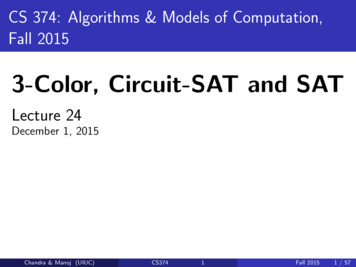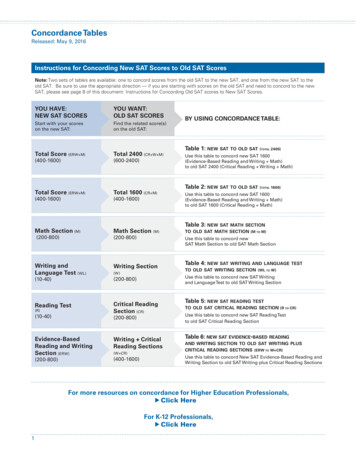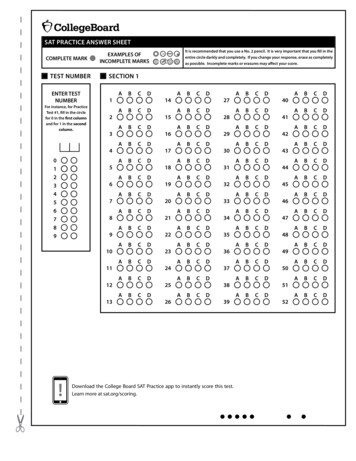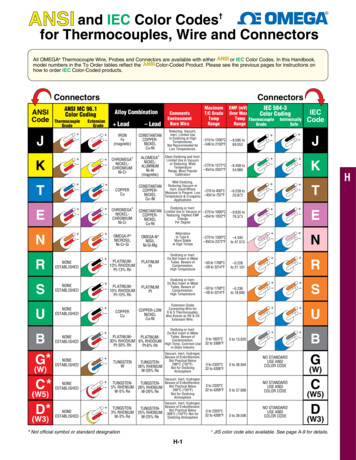
Transcription
CS 374: Algorithms & Models of Computation,Fall 20153-Color, Circuit-SAT and SATLecture 24December 1, 2015Chandra & Manoj (UIUC)CS3741Fall 20151 / 57
RecapNP: languages that have non-deterministic polynomial timealgorithmsChandra & Manoj (UIUC)CS3742Fall 20152 / 57
RecapNP: languages that have non-deterministic polynomial timealgorithmsA language L is NP-Complete iffL is in NPfor every L0 in NP, L0 P LChandra & Manoj (UIUC)CS3742Fall 20152 / 57
RecapNP: languages that have non-deterministic polynomial timealgorithmsA language L is NP-Complete iffL is in NPfor every L0 in NP, L0 P LL is NP-Hard if for every L0 in NP, L0 P L.Chandra & Manoj (UIUC)CS3742Fall 20152 / 57
RecapNP: languages that have non-deterministic polynomial timealgorithmsA language L is NP-Complete iffL is in NPfor every L0 in NP, L0 P LL is NP-Hard if for every L0 in NP, L0 P L.Theorem (Cook-Levin)SAT is NP-Complete.Chandra & Manoj (UIUC)CS3742Fall 20152 / 57
Pictorial ViewNP-HardNP-CNPPChandra & Manoj (UIUC)CS3743Fall 20153 / 57
P and NPPossible scenarios:1P NP.2P 6 NPChandra & Manoj (UIUC)CS3744Fall 20154 / 57
P and NPPossible scenarios:1P NP.2P 6 NPQuestion: Suppose P 6 NP. Is every problem in NP \ P alsoNP-Complete?Chandra & Manoj (UIUC)CS3744Fall 20154 / 57
P and NPPossible scenarios:1P NP.2P 6 NPQuestion: Suppose P 6 NP. Is every problem in NP \ P alsoNP-Complete?Theorem (Ladner)If P 6 NP then there is a problem/language X NP \ P such thatX is not NP-Complete.Chandra & Manoj (UIUC)CS3744Fall 20154 / 57
TodayNP-Completeness of three problems:3-ColorCircuit SATSAT (Cook-Levin Theorem)Important: understanding the problems and that they are hard.Proofs and reductions will be sketchy and mainly to give a flavorChandra & Manoj (UIUC)CS3745Fall 20155 / 57
Part INP-Completeness of GraphColoringChandra & Manoj (UIUC)CS3746Fall 20156 / 57
Graph ColoringProblem: Graph ColoringInstance: G (V , E ): Undirected graph, integer k.Question: Can the vertices of the graph be coloredusing k colors so that vertices connected by an edge donot get the same color?Chandra & Manoj (UIUC)CS3747Fall 20157 / 57
Graph 3-ColoringProblem: 3 ColoringInstance: G (V , E ): Undirected graph.Question: Can the vertices of the graph be coloredusing 3 colors so that vertices connected by an edge donot get the same color?Chandra & Manoj (UIUC)CS3748Fall 20158 / 57
Graph 3-ColoringProblem: 3 ColoringInstance: G (V , E ): Undirected graph.Question: Can the vertices of the graph be coloredusing 3 colors so that vertices connected by an edge donot get the same color?Chandra & Manoj (UIUC)CS3748Fall 20158 / 57
Graph ColoringObservation: If G is colored with k colors then each color class(nodes of same color) form an independent set in G . Thus, G can bepartitioned into k independent sets iff G is k-colorable.Chandra & Manoj (UIUC)CS3749Fall 20159 / 57
Graph ColoringObservation: If G is colored with k colors then each color class(nodes of same color) form an independent set in G . Thus, G can bepartitioned into k independent sets iff G is k-colorable.Graph 2-Coloring can be decided in polynomial time.Chandra & Manoj (UIUC)CS3749Fall 20159 / 57
Graph ColoringObservation: If G is colored with k colors then each color class(nodes of same color) form an independent set in G . Thus, G can bepartitioned into k independent sets iff G is k-colorable.Graph 2-Coloring can be decided in polynomial time.G is 2-colorable iff G is bipartite!Chandra & Manoj (UIUC)CS3749Fall 20159 / 57
Graph ColoringObservation: If G is colored with k colors then each color class(nodes of same color) form an independent set in G . Thus, G can bepartitioned into k independent sets iff G is k-colorable.Graph 2-Coloring can be decided in polynomial time.G is 2-colorable iff G is bipartite! There is a linear time algorithm tocheck if G is bipartite using BFSChandra & Manoj (UIUC)CS3749Fall 20159 / 57
Graph Coloring and Register AllocationRegister AllocationAssign variables to (at most) k registers such that variables neededat the same time are not assigned to the same registerInterference GraphVertices are variables, and there is an edge between two vertices, ifthe two variables are “live” at the same time.Observations[Chaitin] Register allocation problem is equivalent to coloring theinterference graph with k colorsMoreover, 3-COLOR P k-Register Allocation, for anyk 3Chandra & Manoj (UIUC)CS37410Fall 201510 / 57
Class Room SchedulingGiven n classes and their meeting times, are k rooms sufficient?Chandra & Manoj (UIUC)CS37411Fall 201511 / 57
Class Room SchedulingGiven n classes and their meeting times, are k rooms sufficient?Reduce to Graph k-Coloring problemCreate graph Ga node vi for each class ian edge between vi and vj if classes i and j conflictChandra & Manoj (UIUC)CS37411Fall 201511 / 57
Class Room SchedulingGiven n classes and their meeting times, are k rooms sufficient?Reduce to Graph k-Coloring problemCreate graph Ga node vi for each class ian edge between vi and vj if classes i and j conflictExercise: G is k-colorable iff k rooms are sufficientChandra & Manoj (UIUC)CS37411Fall 201511 / 57
Frequency Assignments in Cellular NetworksCellular telephone systems that use Frequency Division MultipleAccess (FDMA) (example: GSM in Europe and Asia and AT&T inUSA)Breakup a frequency range [a, b] into disjoint bands offrequencies [a0 , b0 ], [a1 , b1 ], . . . , [ak , bk ]Each cell phone tower (simplifying) gets one bandConstraint: nearby towers cannot be assigned same band,otherwise signals will interferenceChandra & Manoj (UIUC)CS37412Fall 201512 / 57
Frequency Assignments in Cellular NetworksCellular telephone systems that use Frequency Division MultipleAccess (FDMA) (example: GSM in Europe and Asia and AT&T inUSA)Breakup a frequency range [a, b] into disjoint bands offrequencies [a0 , b0 ], [a1 , b1 ], . . . , [ak , bk ]Each cell phone tower (simplifying) gets one bandConstraint: nearby towers cannot be assigned same band,otherwise signals will interferenceProblem: given k bands and some region with n towers, is there away to assign the bands to avoid interference?Can reduce to k-coloring by creating intereference/conflict graph ontowers.Chandra & Manoj (UIUC)CS37412Fall 201512 / 57
3 color this gadget.You are given three colors: red, green and blue. Can the followinggraph be three colored in a valid way (assuming that some of thenodes are already colored as indicated).(A) Yes.(B) No.Chandra & Manoj (UIUC)CS37413Fall 201513 / 57
3 color this gadget IIYou are given three colors: red, green and blue. Can the followinggraph be three colored in a valid way (assuming that some of thenodes are already colored as indicated).(A) Yes.(B) No.Chandra & Manoj (UIUC)CS37414Fall 201514 / 57
3-Coloring is NP-Complete3-Coloring is in NP.Non-deterministically guess a 3-coloring for each nodeCheck if for each edge (u, v ), the color of u is different fromthat of v .Hardness: We will show 3-SAT P 3-Coloring.Chandra & Manoj (UIUC)CS37415Fall 201515 / 57
Reduction IdeaStart with 3SAT formula (i.e., 3CNF formula) ϕ with n variablesx1 , . . . , xn and m clauses C1 , . . . , Cm . Create graph Gϕ such thatGϕ is 3-colorable iff ϕ is satisfiableneed to establish truth assignment for x1 , . . . , xn via colors forsome nodes in Gϕ .Chandra & Manoj (UIUC)CS37416Fall 201516 / 57
Reduction IdeaStart with 3SAT formula (i.e., 3CNF formula) ϕ with n variablesx1 , . . . , xn and m clauses C1 , . . . , Cm . Create graph Gϕ such thatGϕ is 3-colorable iff ϕ is satisfiableneed to establish truth assignment for x1 , . . . , xn via colors forsome nodes in Gϕ .create triangle with node True, False, BaseChandra & Manoj (UIUC)CS37416Fall 201516 / 57
Reduction IdeaStart with 3SAT formula (i.e., 3CNF formula) ϕ with n variablesx1 , . . . , xn and m clauses C1 , . . . , Cm . Create graph Gϕ such thatGϕ is 3-colorable iff ϕ is satisfiableneed to establish truth assignment for x1 , . . . , xn via colors forsome nodes in Gϕ .create triangle with node True, False, Basefor each variable xi two nodes vi and v̄i connected in a trianglewith common BaseChandra & Manoj (UIUC)CS37416Fall 201516 / 57
Reduction IdeaStart with 3SAT formula (i.e., 3CNF formula) ϕ with n variablesx1 , . . . , xn and m clauses C1 , . . . , Cm . Create graph Gϕ such thatGϕ is 3-colorable iff ϕ is satisfiableneed to establish truth assignment for x1 , . . . , xn via colors forsome nodes in Gϕ .create triangle with node True, False, Basefor each variable xi two nodes vi and v̄i connected in a trianglewith common BaseIf graph is 3-colored, either vi or v̄i gets the same color as True.Interpret this as a truth assignment to viChandra & Manoj (UIUC)CS37416Fall 201516 / 57
Reduction IdeaStart with 3SAT formula (i.e., 3CNF formula) ϕ with n variablesx1 , . . . , xn and m clauses C1 , . . . , Cm . Create graph Gϕ such thatGϕ is 3-colorable iff ϕ is satisfiableneed to establish truth assignment for x1 , . . . , xn via colors forsome nodes in Gϕ .create triangle with node True, False, Basefor each variable xi two nodes vi and v̄i connected in a trianglewith common BaseIf graph is 3-colored, either vi or v̄i gets the same color as True.Interpret this as a truth assignment to viNeed to add constraints to ensure clauses are satisfied (nextphase)Chandra & Manoj (UIUC)CS37416Fall 201516 / 57
FigureTFvnBasev1vnv1v2v2Chandra & Manoj (UIUC)CS37417Fall 201517 / 57
Clause Satisfiability GadgetFor each clause Cj (a b c), create a small gadget graphgadget graph connects to nodes corresponding to a, b, cneeds to implement OROR-gadget-graph:aa ba b cbcChandra & Manoj (UIUC)CS37418Fall 201518 / 57
OR-Gadget GraphProperty: if a, b, c are colored False in a 3-coloring then output nodeof OR-gadget has to be colored False.Property: if one of a, b, c is colored True then OR-gadget can be3-colored such that output node of OR-gadget is colored True.Chandra & Manoj (UIUC)CS37419Fall 201519 / 57
Reductioncreate triangle with nodes True, False, Basefor each variable xi two nodes vi and v̄i connected in a trianglewith common Basefor each clause Cj (a b c), add OR-gadget graph withinput nodes a, b, c and connect output node of gadget to bothFalse and Baseaa bTa b cbBasecChandra & Manoj (UIUC)FCS37420Fall 201520 / 57
Reductionaa bTa b cbBasecFClaimNo legal 3-coloring of above graph (with coloring of nodes T , F , Bfixed) in which a, b, c are colored False. If any of a, b, c are coloredTrue then there is a legal 3-coloring of above graph.Chandra & Manoj (UIUC)CS37421Fall 201521 / 57
3 coloring of the clause gadgetauwvbarwTscubvFFF - BADaawTscbbvbvwTscuTTFChandra & Manoj uwscarTFTrTscTTTCS37422Fall 201522 / 57
Reduction OutlineExampleϕ (u v w ) (v x y )Variable and negationhave complementarycoloursLiterals get colour T or FPaletteTFNOR gatesChandra & Manoj (UIUC) uu vv ww xx yyCS37423Fall 201523 / 57
Correctness of Reductionϕ is satisfiable implies Gϕ is 3-colorableif xi is assigned True, color vi True and v̄i FalseChandra & Manoj (UIUC)CS37424Fall 201524 / 57
Correctness of Reductionϕ is satisfiable implies Gϕ is 3-colorableif xi is assigned True, color vi True and v̄i Falsefor each clause Cj (a b c) at least one of a, b, c iscolored True. OR-gadget for Cj can be 3-colored such thatoutput is True.Chandra & Manoj (UIUC)CS37424Fall 201524 / 57
Correctness of Reductionϕ is satisfiable implies Gϕ is 3-colorableif xi is assigned True, color vi True and v̄i Falsefor each clause Cj (a b c) at least one of a, b, c iscolored True. OR-gadget for Cj can be 3-colored such thatoutput is True.Chandra & Manoj (UIUC)CS37424Fall 201524 / 57
Correctness of Reductionϕ is satisfiable implies Gϕ is 3-colorableif xi is assigned True, color vi True and v̄i Falsefor each clause Cj (a b c) at least one of a, b, c iscolored True. OR-gadget for Cj can be 3-colored such thatoutput is True.Gϕ is 3-colorable implies ϕ is satisfiableif vi is colored True then set xi to be True, this is a legal truthassignmentChandra & Manoj (UIUC)CS37424Fall 201524 / 57
Correctness of Reductionϕ is satisfiable implies Gϕ is 3-colorableif xi is assigned True, color vi True and v̄i Falsefor each clause Cj (a b c) at least one of a, b, c iscolored True. OR-gadget for Cj can be 3-colored such thatoutput is True.Gϕ is 3-colorable implies ϕ is satisfiableif vi is colored True then set xi to be True, this is a legal truthassignmentconsider any clause Cj (a b c). it cannot be that alla, b, c are False. If so, output of OR-gadget for Cj has to becolored False but output is connected to Base and False!Chandra & Manoj (UIUC)CS37424Fall 201524 / 57
Graph generated in reduction. from 3SAT to 3COLORTFXaaChandra & Manoj (UIUC)bcbCS374cd25dFall 201525 / 57
Part IICircuit SATChandra & Manoj (UIUC)CS37426Fall 201526 / 57
CircuitsDefinitionA circuit is a directed acyclic graph with1Input vertices (withoutincoming edges) labelled with0, 1 or a distinct variable.2Every other vertex is labelled , or .3Single node output vertexwith no outgoing edges.Inputs: 1?0?Chandra & Manoj (UIUC)CS37427Fall 201527 / 57
CircuitsDefinitionA circuit is a directed acyclic graph with 1Input vertices (withoutincoming edges) labelled with0, 1 or a distinct variable. 2Every other vertex is labelled , or . 3Single node output vertexwith no outgoing edges.Inputs: 1?0?Chandra & Manoj (UIUC)CS37427Fall 201527 / 57
CircuitsDefinitionA circuit is a directed acyclic graph withOutput: 1Input vertices (withoutincoming edges) labelled with0, 1 or a distinct variable. 2Every other vertex is labelled , or . 3Single node output vertexwith no outgoing edges.Inputs: 1?0?Chandra & Manoj (UIUC)CS37427Fall 201527 / 57
CSAT: Circuit SatisfactionDefinition (Circuit Satisfaction (CSAT).)Given a circuit as input, is there an assignment to the input variablesthat causes the output to get value 1?Chandra & Manoj (UIUC)CS37428Fall 201528 / 57
CSAT: Circuit SatisfactionDefinition (Circuit Satisfaction (CSAT).)Given a circuit as input, is there an assignment to the input variablesthat causes the output to get value 1?ClaimCSAT is in NP.12Certificate: Assignment to input variables.Certifier: Evaluate the value of each gate in a topological sort ofDAG and check the output gate value.Chandra & Manoj (UIUC)CS37428Fall 201528 / 57
Circuit SAT vs SATCNF formulas are a rather restricted form of Boolean formulas.Circuits are a much more powerful (and hence easier) way to expressBoolean formulasChandra & Manoj (UIUC)CS37429Fall 201529 / 57
Circuit SAT vs SATCNF formulas are a rather restricted form of Boolean formulas.Circuits are a much more powerful (and hence easier) way to expressBoolean formulasHowever they are equivalent in terms of polynomial-time solvability.TheoremSAT P 3SAT P CSAT.TheoremCSAT P SAT P 3SAT.Chandra & Manoj (UIUC)CS37429Fall 201529 / 57
Converting a CNF formula into a CircuitGiven 3CNF formulat ϕ with n variables and m clauses, create aCircuit C .Inputs to C are the n boolean variables x1 , x2 , . . . , xnUse NOT gate to generate literal xi for each variable xiFor each clause ( 1 2 3 ) use two OR gates to mimicformulaCombine the outputs for the clauses using AND gates to obtainthe final outputChandra & Manoj (UIUC)CS37430Fall 201530 / 57
Example ϕ x1 x3 x4 x1 x2 x3 x2 x3 x4Chandra & Manoj (UIUC)CS37431Fall 201531 / 57
Converting a circuit into a CNF formulaLabel the nodesOutput:Output: , k 1 ? ?0 , f?1,aInputs , h , g?,b?,c?,e0,dInputs(A) Input circuitChandra & Manoj (UIUC) , j , i(B) Label the nodes.CS37432Fall 201532 / 57
Converting a circuit into a CNF formulaIntroduce a variable for each nodeOutput: , k1,axi , j , i , fOutput: , k?,bxf , h , g?,c0,d?,exa 1,aInputs , j , i , gxgxb ?,b xc?,c , fxj , hxd 0,dxhxe ?,eInputs(B) Label the nodes.Chandra & Manoj (UIUC)xk(C) Introduce var for each node.CS37433Fall 201533 / 57
Converting a circuit into a CNF formulaWrite a sub-formula for each variable that is true if the var is computed correctly.Output: , kxixfxa 1,axk , j , i , gxgxb ?,b xc?,c , fxj , hxd 0,dxhxe ?,eInputs(C) Introduce var for each node.Chandra & Manoj (UIUC)CS374xk (Demand a sat’ assignment!)xk xi xkxj xg xhxi xfxh xd xexg xb xcxf xa xbxd 0xa 1(D) Write a sub-formula foreach variable that is true if thevar is computed correctly.34Fall 201534 / 57
Converting a circuit into a CNF formulaConvert each sub-formula to an equivalent CNF formulaxkxk xi xjxj xg xhxi xfxh xd xexg xb xcxf xa xbxd 0xa 1Chandra & Manoj (UIUC)xk( xk xi ) ( xk xj ) (xk xi xj )( xj xg ) ( xj xh ) (xj xg xh )(xi xf ) ( xi xf )(xh xd ) (xh xe ) ( xh xd xe )(xg xb ) (xg xc ) ( xg xb xc )( xf xa ) ( xf xb ) (xf xa xb ) xdxaCS37435Fall 201535 / 57
Converting a circuit into a CNF formulaTake the conjunction of all the CNF sub-formulasOutput: , kxixfxa 1,axk , j , i , gxgxb ?,b xc?,c , fxj , hxd 0,dxhxe ?,eInputsxk ( xk xi ) ( xk xj ) (xk xi xj ) ( xj xg ) ( xj xh ) (xj xg xh ) (xi xf ) ( xi xf ) (xh xd ) (xh xe ) ( xh xd xe ) (xg xb ) (xg xc ) ( xg xb xc ) ( xf xa ) ( xf xb ) (xf xa xb ) ( xd ) xaWe got a CNF formula that is satisfiable if and only if the originalcircuit is satisfiable.Chandra & Manoj (UIUC)CS37436Fall 201536 / 57
Reduction: CSAT P SAT12For each gate (vertex) v in the circuit, create a variable xvCase : v is labeled and has one incoming edge from u (soxv xu ). In SAT formula generate, add clauses (xu xv ),( xu xv ). Observe thatxv xu is trueChandra & Manoj (UIUC) CS374(xu xv )both true.( xu xv )37Fall 201537 / 57
Reduction: CSAT P SATContinued.1Case : So xv xu xw . In SAT formula generated, addclauses (xv xu ), (xv xw ), and ( xv xu xw ). Again,observe that xv xu xwChandra & Manoj (UIUC) is trueCS374(xv xu ),(xv xw ),all true.( xv xu xw ) 38Fall 201538 / 57
Reduction: CSAT P SATContinued.1Case : So xv xu xw . In SAT formula generated, addclauses ( xv xu ), ( xv xw ), and (xv xu xw ).Again observe thatxv xu xw is trueChandra & Manoj (UIUC) CS374( xv xu ),( xv xw ),all true.(xv xu xw )39Fall 201539 / 57
Reduction: CSAT P SATContinued.12If v is an input gate with a fixed value then we do the following.If xv 1 add clause xv . If xv 0 add clause xvAdd the clause xv where v is the variable for the output gateChandra & Manoj (UIUC)CS37440Fall 201540 / 57
Correctness of ReductionNeed to show circuit C is satisfiable iff ϕC is satisfiable Consider a satisfying assignment a for C123Find values of all gates in C under aGive value of gate v to variable xv ; call this assignment a 0a 0 satisfies ϕC (exercise) Consider a satisfying assignment a for ϕC123Let a 0 be the restriction of a to only the input variablesValue of gate v under a 0 is the same as value of xv in aThus, a 0 satisfies CChandra & Manoj (UIUC)CS37441Fall 201541 / 57
Part IIIProof of Cook-Levin TheoremChandra & Manoj (UIUC)CS37442Fall 201542 / 57
Cook-Levin TheoremTheorem (Cook-Levin)SAT is NP-Complete.We have already seen that SAT is in NP.Need to prove that every language L NP, L P SATChandra & Manoj (UIUC)CS37443Fall 201543 / 57
Cook-Levin TheoremTheorem (Cook-Levin)SAT is NP-Complete.We have already seen that SAT is in NP.Need to prove that every language L NP, L P SATDifficulty: Infinite number of languages in NP. Must simultaneouslyshow a generic reduction strategy.Chandra & Manoj (UIUC)CS37443Fall 201543 / 57
High-level PlanWhat does it mean that L NP?L NP implies that there is a non-deterministic TM M andpolynomial p() such thatL {x Σ M accepts x in at most p( x ) steps}Chandra & Manoj (UIUC)CS37444Fall 201544 / 57
High-level PlanWhat does it mean that L NP?L NP implies that there is a non-deterministic TM M andpolynomial p() such thatL {x Σ M accepts x in at most p( x ) steps}We will describe a reduction fM that depends on M, p such that:fM takes as input a string x and outputs a SAT formula fM (x)fM runs in time polynomial in x x L if and only if fM (x) is satisfiableChandra & Manoj (UIUC)CS37444Fall 201544 / 57
Plan continuedxfMfM (x)poly-time computablefM (x) is satisfiable if and only if x LfM (x) is satisfiable if and only if non-det M accepts x in p( x ) stepsChandra & Manoj (UIUC)CS37445Fall 201545 / 57
Plan continuedxfMfM (x)poly-time computablefM (x) is satisfiable if and only if x LfM (x) is satisfiable if and only if non-det M accepts x in p( x ) stepsBIG IDEAfM (x) will express “M on input x accepts in p( x ) steps”fM (x) will encode a computation history of M on xfM (x) will be a carefully constructed CNF formulat s.t if we have asatisfying assignment to it, then we will be able to see a completeaccepting computation of M on x down to the last detail of wherethe head is, what transistion is chosen, what the tape contents are,at each step.Chandra & Manoj (UIUC)CS37445Fall 201545 / 57
Tableu of ComputationM runs in time p( x ) on x. Entire computation of M on x can berepresented by a “tableau”tape cell position1 2 3 40 1 0 0 11 0 0 0 123p( x )blanksstate q0blanksstate q2timep( x )Row i gives contents of all cells at time iAt time 0 tape has input x followed by blanksEach row long enough to hold all cells M might ever have scanned.Chandra & Manoj (UIUC)CS37446Fall 201546 / 57
Variable of fM (x)Four types of variable to describe computation of M on xT (b, h, i ) : tape cell at position h holds symbol b at time i .1 h p( x ), b Γ, 0 i p( x )H(h, i ): read/write head is at position h at time i .1 h p( x ), 0 i p( x )S(q, i ) state of M is q at time i q Q, 0 i p( x )I (j , i ) instruction number j is executed at time iM is non-deterministic, need to specify transitions in some way.Number transitions as 1, 2, . . . , where j ’th transition is qj , bj , qj0 , bj0 , dj indication (qj0 , bj0 , dj ) δ(qj , bj ),direction dj { 1, 0, 1}.Number of variables is O(p( x )2 ) where constant in O() hidesdependence on fixed machine M.Chandra & Manoj (UIUC)CS37447Fall 201547 / 57
NotationSomeVm abbreviations for ease of notationk 1 xk means x1 x2 . . . xmWmk 1xk means x1 x2 . . . xmL(x1 , x2 , . . . , xk ) is a formula that means exactly one ofx1 , x2 , . . . , xm is true. Can be converted to CNF formChandra & Manoj (UIUC)CS37448Fall 201548 / 57
Clauses of fM (x)fM (x) is the conjunction of 8 clause groups:fM (x) ϕ1 ϕ2 ϕ3 ϕ4 ϕ5 ϕ6 ϕ7 ϕ8where each ϕi is a CNF formula. Described in subsequent slides.Property: fM (x) is satisfied iff there is a truth assignment to thevariables that simultaneously satisfy ϕ1 , . . . , ϕ8 .Chandra & Manoj (UIUC)CS37449Fall 201549 / 57
ϕ1ϕ1 asserts (is true iff) the variables are set T/F indicating that Mstarts in state q0 at time 0 with tape contents containing x followedby blanks.Let x a1 a2 . . . anϕV1 S(q, 0) state at time 0 is q0VnandT (ah , h, 0) at time 0 cells 1 to n have a1 to anVh 1p( x Vh n 1 )T (B, h, 0) at time 0 cells n 1 to p( x ) have blanksandH(1, 0)head at time 0 is in position 1Chandra & Manoj (UIUC)CS37450Fall 201550 / 57
ϕ2ϕ2 asserts M in exactly one state at any time iϕ2 Vp( x )i 0 (S(q0 , i ), S(q1 , i ), . . . , S(q Q , i ))Chandra & Manoj (UIUC)CS37451Fall 201551 / 57
ϕ3ϕ3 asserts that each tape cell holds a unique symbol at any giventime.p( x ) p( x )ϕ3 i 0 (T (b1 , h, i ), T (b2 , h, i ), . . . , T (b Γ , h, i ))h 1For each time i and for each cell position h exactly one symbolb Γ at cell position h at time iChandra & Manoj (UIUC)CS37452Fall 201552 / 57
ϕ4ϕ4 asserts that the read/write head of M is in exactly one positionat any time ip( x )ϕ4 ( (H(1, i ), H(2, i ), . . . , H(p( x ), i )))i 0Chandra & Manoj (UIUC)CS37453Fall 201553 / 57
ϕ5ϕ5 asserts that M acceptsLet qa be unique accept state of Mwithout loss of generality assume M runs all p( x ) stepsϕ5 S(qa , p( x ))State at time p( x ) is qa the accept state.If we don’t want to make assumption of running for all stepsp( x )ϕ5 S(qa , i )i 1which means M enters accepts state at some time.Chandra & Manoj (UIUC)CS37454Fall 201554 / 57
ϕ6ϕ6 asserts that M executes a unique instruction at each timep( x )ϕ6 (I (1, i ), I (2, i ), . . . , I (m, i ))i 0where m is max instruction number.Chandra & Manoj (UIUC)CS37455Fall 201555 / 57
ϕ7ϕ7 ensures that variables don’t allow tape to change from onemoment to next if the read/write head was not there.“If head is not at position h at time i then at time i 1 the symbolat cell h must be unchanged” H(h, i ) T (b, h, i ) T (c, h, i 1)ϕ7 ih b6 csince A B is same as A B, rewrite above in CNF formϕ7 i(H(h, i ) T (b, h, i ) T (c, h, i 1))h b6 cChandra & Manoj (UIUC)CS37456Fall 201556 / 57
ϕ8ϕ8 asserts that changes in tableu/tape correspond to transitions ofM (as Lenny says, this is the big cookie).Let j ’th instruction be qj , bj , qj0 , bj0 , dj V VϕV8 i j (I (j , i ) S(qj , i )) If instr j executed at time i then state must be correct to do jV V0Vi j (I (j , i ) S(qj , i 1)) and at next time unit, state must be the proper next state for instr jV V VVH(h,Vi )) T (bj , h, i )] if j was executed and head was atihj [(I (j , i )position h, then cell h has correct symbol for jV V V0i 1)] if j was done then at time i withijh [(I (j , i ) H(h, i )) T (bj , h,Vhead at h then at next time step symbol bj0 was indeed written in position hV V Vijh [(I (j , i ) H(h, i )) H(h dj , i 1)] and head is moved properlyaccording to instr j .Chandra & Manoj (UIUC)CS37457Fall 201557 / 57
Proof of Correctness(Sketch)Given M, x, poly-time algorithm to construct fM (x)if fM (x) is satisfiable then the truth assignment completelyspecifies an accepting computation of M on xif M accepts x then the accepting computation leads to an”obvious” truth assignment to fM (x). Simply assign thevariables according to the state of M and cells at each time i .Thus M accepts x if and only if fM (x) is satisfiableChandra & Manoj (UIUC)CS37458Fall 201558 / 57
3-Color, Circuit-SAT and SAT Lecture 24 December 1, 2015 Chandra & Manoj (UIUC) CS374 1 Fall 2015 1 / 57. Recap . Graph 2-Coloring can be decided in polynomial time. G is 2-colorable i G is bipartite! There is a linear time algorithm to check if G is bipartite using BFS Chandra & Manoj (UIUC) CS374 9 Fall 2015 9 / 57 .










